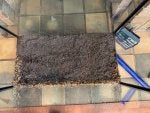Greetings all,
A couple weeks ago at a dinner party a friend of mine said, "you know what would look great in this house? An aquarium." I'm not sure which part of my interior designer or inner child he spoke to, but the comment struck a chord. A few days later I was down at my local fish store. The biggest question I had was, "how long can an aquarium tank go without maintenance?" You see, my wife and I are both teachers and we use our summers to travel for extended periods. A tank that required water changes every week would simply not do. It's one thing to ask a neighbor to come over and feed your fish every so often. It's another to ask them to break out the hose-bong-bucket contraption and start siphoning.
Fortunately, an astute employee and aquarist pointed out that a heavily planted tank can go as long as 3 months without water changes. This insight led me down the path of MD Fish Tanks, Bentley, Diana Walstad, and eventually to TPT.
A week later I had assembled all the ingredients to launch a planted, Walstad-inspired 30 gallon aquarium in our sealed fireplace. In my enthusiasm, I had foolishly purchased the plants as well. I had 24 hours to launch this tank. YouTube made it look so easy, so how hard could it be?
Here is my journey. I hope you'll help me along!
![Image]()
A couple weeks ago at a dinner party a friend of mine said, "you know what would look great in this house? An aquarium." I'm not sure which part of my interior designer or inner child he spoke to, but the comment struck a chord. A few days later I was down at my local fish store. The biggest question I had was, "how long can an aquarium tank go without maintenance?" You see, my wife and I are both teachers and we use our summers to travel for extended periods. A tank that required water changes every week would simply not do. It's one thing to ask a neighbor to come over and feed your fish every so often. It's another to ask them to break out the hose-bong-bucket contraption and start siphoning.
Fortunately, an astute employee and aquarist pointed out that a heavily planted tank can go as long as 3 months without water changes. This insight led me down the path of MD Fish Tanks, Bentley, Diana Walstad, and eventually to TPT.
A week later I had assembled all the ingredients to launch a planted, Walstad-inspired 30 gallon aquarium in our sealed fireplace. In my enthusiasm, I had foolishly purchased the plants as well. I had 24 hours to launch this tank. YouTube made it look so easy, so how hard could it be?
Here is my journey. I hope you'll help me along!


















